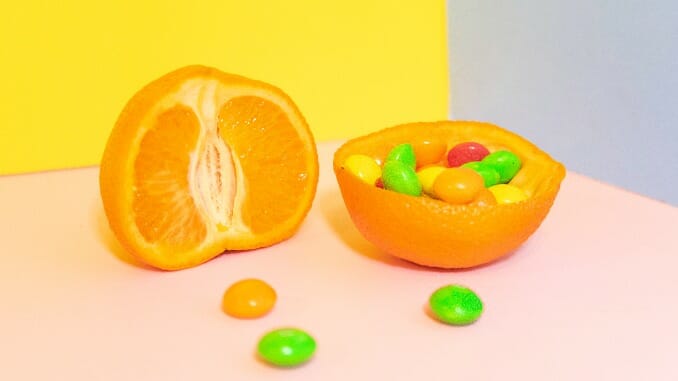Introducing Endless Mode: A New Games & Anime Site from Paste
I recently came across a recipe for no-knead Gatorade bread on a Substack entitled Food is Stupid by Chicago-based food writer Dennis Lee. The crust of the bread looks relatively inoffensive, but when sliced, the loaf is revealed to have taken on a pale blue color, mimicking the blandness of the unbaked drink’s flavor that replaced water in the recipe.
As it turns out, the Gatorade bread is not this writer’s only gift to the internet. Other titles on the Substack include “Can you carbonate raw fish? If so, should you?” and the deeply ominous “S’moysters.” That’s to say nothing of the communion wafer Nachos Bel Grande or the salmon roe boba tea. As I read through these pieces of art, one thing remained constant: I laughed my ass off the entire time. Ask me what the joke is, and I couldn’t tell you; I just know that this is pure comedic gold.
Lee isn’t the only food media figure that’s developing laughable, inedible dishes that nobody would ever dream of reproducing in their own kitchen. The TikTok account @asianmuminlaw produces similar content with a nod to molecular gastronomy, complete with a terrifying tutorial for a lobster and a whole octopus stuffed in a chicken’s various orifices and butter made from human breastmilk. It’s the food media’s adoption of absurdism, and it doesn’t end with recipes: You can witness @thecheerioman stringing Spaghetti-Os onto the drawstring of his sweatpants and @wunderaroma putting clam juice in a humidifier for an ad.
How did we get to this point? Why are these posts so funny, and why are people making them? It’s not a surprise that we as a culture have circled back to the absurd. Dadaism, an absurdist art movement, flourished during World War I as a response to the atrocities of war. Absurdist art proliferated again in the difficult years of World War II and after; Albert Camus’ The Myth of Sisyphus was published in October 1942, right in the middle of the worldwide crisis. Samuel Beckett’s Waiting for Godot was first performed eleven years later while the Cold War simmered on in its early years.
We seem to find ourselves in a similar moment of global tension now, and it’s not just the artists who are contemplating the absurd. The Atlantic writer Peter Pomerantsev describes Kremlin advisor Vladislav Surkov as “the hidden author of Putinism” and attributes a novel brand of authoritarianism to him, a “new type of authoritarianism… that instead of simply oppressing opposition, as had been the case with 20th-century strains… climbs inside all ideologies and movements, exploiting and rendering them absurd.” Surkov managed this level of absurdism in the heart of Russian politics by funding competing interests, leaving citizens confused about what the Kremlin actually stood for. Pomerantsev writes, “The Kremlin’s idea is to own all forms of political discourse, to not let any independent movements develop outside of its walls.”
U.S. President Donald Trump seemingly attempted to adopt a similar tone in the months before the 2016 election and throughout his presidency, though arguably less successfully than Surkov. This rhetoric shuffled in the “post-truth” era, a time in which we as a culture cannot seem to agree on even the most basic of facts. Joe Biden’s election in 2020 has done little to shift this dynamic; if anything, it’s made it worse. Half the country believes Biden was not even legitimately elected, and a sizable portion of the left, after fighting so hard to win back the House, the Senate, and the executive branch, has now come to the conclusion that having Democrats in office doesn’t even result in a noticeable shift in policy. And outside of the U.S., ineffective regimes and a slouching toward authoritarianism have become a norm.
The world makes no sense, and nobody seems able to construct a meaningful narrative for a path forward. So it’s understandable that we now find ourselves adopting the language of the absurd once again. The food world was well-poised to move into this space anyway—the Instagrammable food craze of the mid-2010s involving massive milkshakes topped with full slices of cake and a candy store’s worth of sugar and heart attack-inducing burgers with ten patties raunchily dripping with American cheese were already inching toward a nihilistic sense of absurdism. Those concoctions, though, still had an earnestness to them: You clearly weren’t meant to consume these dishes in their entirety, but they were still meant to look appealing, at least.
Lee’s Substack, @asianmuminlaw, and similar forms of media, on the other hand, do not attempt to entice their audiences in the slightest. It’s not clear that this kind of content is meant to have any deeper meaning than evoking feelings of humor, disgust, and morbid fascination. It seems like nothing in the world makes sense anymore, so naturally, untethered humor, humor without a meaning, has its appeal, and food provides a perfect canvas for the culinarily inclined artist.
Could we argue that the Gatorade bread is a metaphor for the microplastics leaching into our water supply or the industrialization of our food systems at the hands of cynical mega-corporations? Sure. But maybe, like our politics and our culture at large, there’s no deeper meaning. Maybe wearing masks causes fungal infections in the lungs, and maybe you should serve Gatorade bread at your next dinner party. Who knows anymore?
